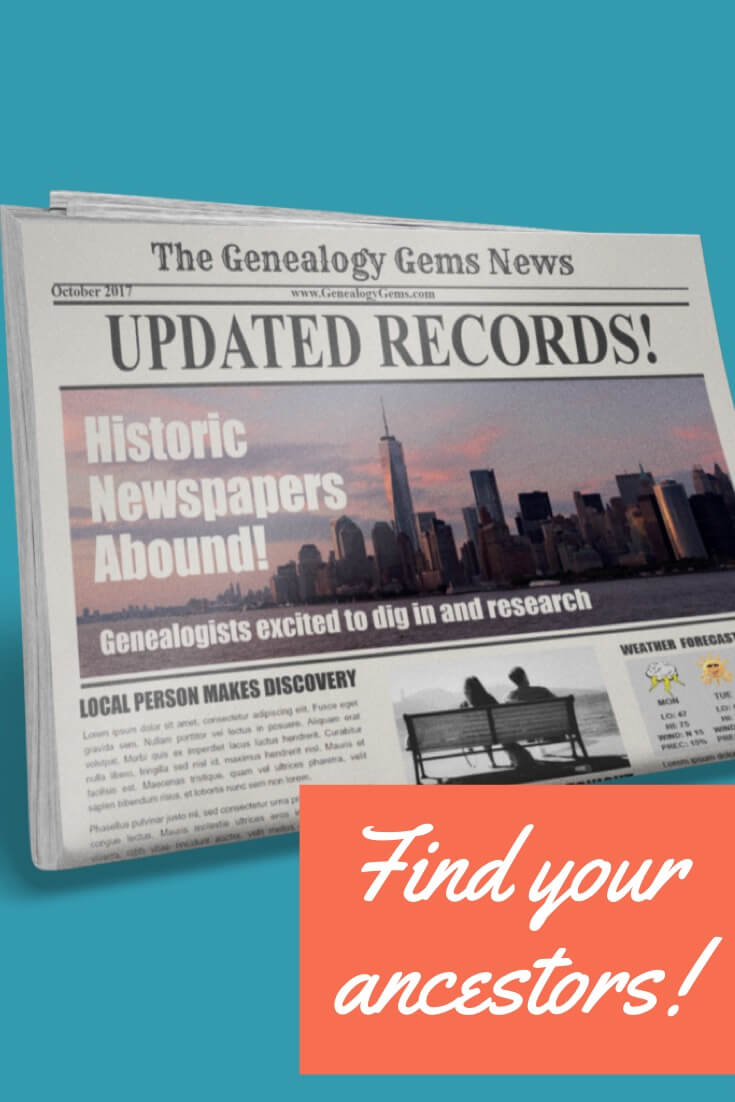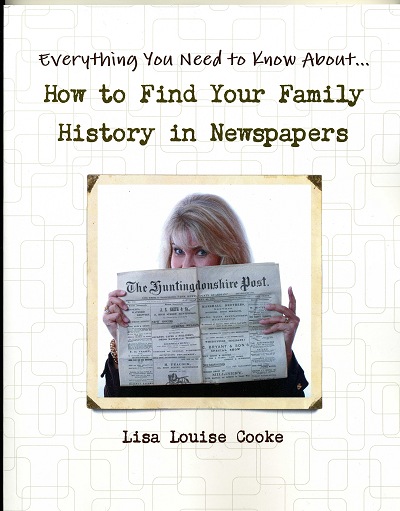Blog

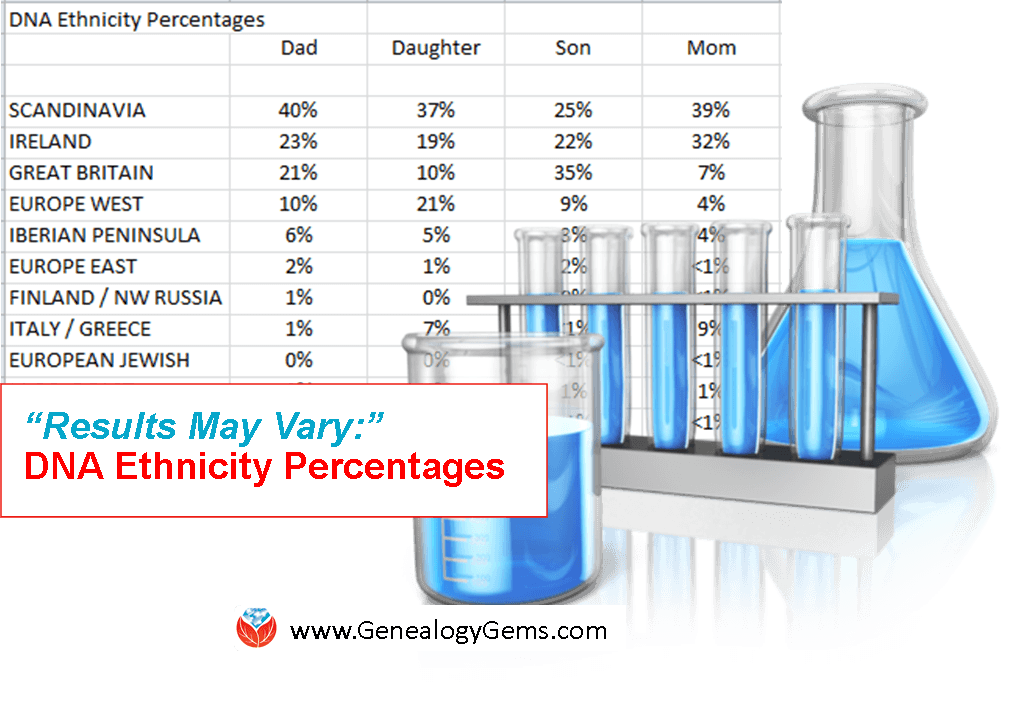
“Results May Vary:” One Family’s DNA Ethnicity Percentages
Four members of a family–mom, dad, daughter, and son–tested with AncestryDNA. Their DNA ethnicity percentages vary. Why?
If you’ve taken a DNA test and received different ethnicity results than you expected and different from your family members, DNA expert Diahan Southard is here to explain why that happens.
There are limitations to the ethnicity results delivered by the various DNA testing companies.
For the most part, these admixture results are like that short film before the actual feature presentation. That feature presentation, in this case, is your genealogical match list. But, the short film is entertaining and certainly keeps your attention for a while. It can be especially interesting when you have several members of the same family tested so you can compare their ethnicity results.

Understanding Ethnicity Variance Within Immediate Families
Let’s consider the real AncestryDNA test results of a family we’ll call the “Reese family:”
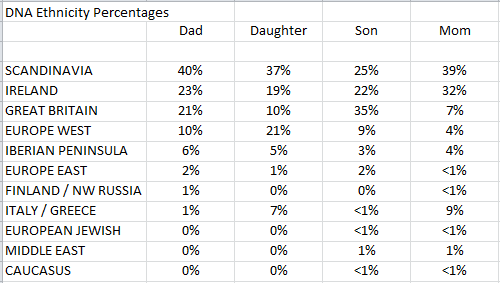
The Reese family has something to their great advantage: their family history indicates that they are mostly from Western Europe. This is a big advantage in the climate of today’s ethnicity results as all of the testing companies have far more data in their reference populations pouring out of western Europe than from anywhere else. (See this article for more information and the latest data on DNA reference populations on each testing company.) That means that in general, they are going to be better at telling you about your heritage from Ireland or England than they are at discovering that you are from China or India.
Looking at the ethnicity results for the Reese family, we are tempted to start applying our knowledge of DNA inheritance to the numbers we see. We know that each child should get half of their DNA from their mom and half from their dad. So our initial reaction might be to look at the dad’s 40% Scandinavian and mom’s 39% Scandinavian and assume that the child would also be about 40% (20% from dad and 20% from mom).
You can see that the daughter did, in fact, mostly measure up to that expectation with 37% Scandinavian. But the son, with only 25%, seems to have fallen short. The temptation to consider the daughter as the far better example of familial inheritance is strong (especially for us daughters, who are so often exceeding expectations!), but of course inaccurate. It is actually very difficult to look at the parent’s numbers alone and estimate the percentages that a child will receive.
A Snippet about SNPs (snips)
Remember that these numbers are tied to actual small pieces of DNA we call SNPs (snips).
Of the near 800,000 SNPs evaluated by your testing company, less than half of them are considered valuable for determining your ethnicity.
The majority of the SNPs tested are working to estimate how closely you are related to your genealogical cousin.
A good SNP for ethnicity purposes has to be ubiquitous enough to show up in many individuals from a given population, but unique enough to only show up in that population, and not any others.
It is a difficult balance to strike. But even when good SNPs are used, it is still difficult for the computer at your testing company to make accurate determinations about your ancestry.
New to using DNA for genealogy? Watch:
(Click on player to unmute sound)
Take the Great Britain line in the Reese family data, for example. The dad has 21% and the mom has 7%, so it would follow that the largest amount any child could have would be 28%. We see the daughter (of course!) falling well within that range at 10%, but the son is seven points above at 35%. How does THAT happen?!
Let’s go back to some basic biology.
Remember that you have two copies of each chromosome: one from mom and one from dad. These chromosomes are made up of strings of letters denoting the DNA code. That means that at each SNP location, you report two letters (again, one from mom and one from dad).
As the testing company is lining these letters up for comparison, they have to decide which letters go together: which are from the same chromosome and which set came from one single source.
Understanding Phasing
The process of determining which set of values goes on which line is called phasing. Often the inconsistencies you see in your DNA test results, whether it be in the matching or in the ethnicity, are because of problems the company has with this very difficult process.
To illustrate how this works, let’s say we are trying to write two sentences: “The brown dog ate the bone.” and “A black cat scared a mouse.”
In this example, each word in each sentence represents a SNP. However, all the computer sees are two words, and it doesn’t know which word goes in which sentence. You can see in this example that it would be fairly easy to get it wrong. Mixing up a couple of words creates entirely new sentences with very different meanings, as shown in the examples below.
Phasing correct:

Phasing incorrect:

It’s important to understand that ethnicity results can, and will, vary among family members as well as different DNA testing companies for the reasons outlined above.
It can certainly be fun to compare what each family member received, but take it with a grain of salt. As you can see, a lot of genetic data is quickly lost over time.
In the Reese family example, we see that in one single generation this family has lost all traces of ancestry to several world regions. This really highlights the value of having the oldest generation of family members tested, to try to capture all that they have to offer in their DNA code.
Get more DNA help and plain-English explanations
If you’re feeling overwhelmed by DNA testing or struggling to make sense of the complex scientific data, our quick reference guides are exactly what you need!
Author and DNA expert Diahan Southard’s collection of DNA guides offer explanations in plain-English, helpful examples and graphics, and practical genealogical applications so you can make the most of your DNA results. Head over to the Genealogy Gems Store to browse our 10 DNA guides available in both print and digital download.

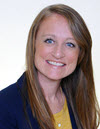
About the Author: Diahan Southard has worked with the Sorenson Molecular Genealogy Foundation, and has been in the genetic genealogy industry since it has been an industry. She holds a degree in Microbiology and her creative side helps her break the science up into delicious bite-sized pieces for you. She’s the author of a full series of DNA guides for genealogists.
Disclosure: This article contains affiliate links and Genealogy Gems will be compensated if you make a purchase after clicking on these links (at no additional cost to you). Thank you for supporting Genealogy Gems!
This article was originally published on February 28, 2016 and updated on March 30, 2019.
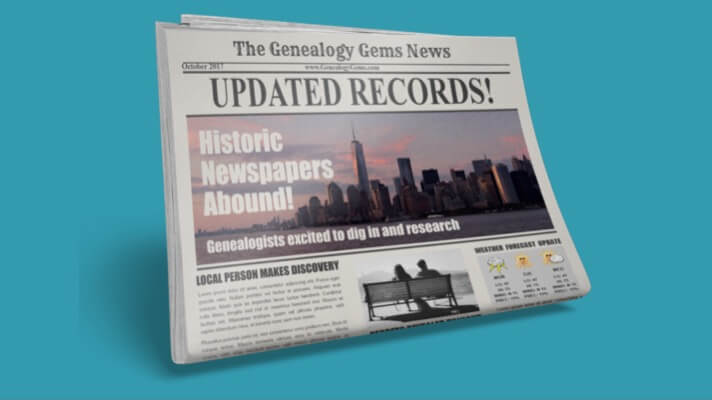
New Genealogy Records Online: Newspapers, Oral Histories, and More
New genealogical records this week include a big update to Genealogy Bank’s newspaper database, including titles from 31 states.
Also new are Massachusetts passenger lists, a Connecticut digitization project, and oral histories for WWII veterans and for Irish history.
Featured Genealogy Records: U.S. Newspapers
Genealogy Bank is a fantastic resource for newspapers and they’ve made a big update this week. New content has been added to 87 titles from 31 different states in the U.S. Some of the largest additions include:
To see all updated titles and states, click here. Discover family history in millions of historical newspaper articles from 1690-1980, including obituaries, birth records, marriage notices, and more facts about your ancestors.
More about Historical Newspapers for Genealogy:
(Click on player to unmute sound)
Massachusetts Passenger Lists
Over at MyHeritage, you’ll find a new collection of Boston, Massachusetts Passenger Lists, 1891-1943. There are 4.8 million records in this data set, so if your ancestors immigrated through Boston, this could be a gold mine! Here’s a little bit of information about the collection from the description:
“Information available varies due to significant changes to immigration laws during the span of this collection. The most common information available includes the passenger’s name, sex, age, date of arrival, and name of the ship.
More detailed passenger manifests collected additional information including marital status, birth information (date and location), nationality, last residence, home city, port of departure, as well as the names and addresses of family members in the United States and home country. This collection is comprised of NARA publication T843.”
Connecticut Historical Footage Digitization
Tasha Caswell is the research and collections associate for the Connecticut Historical Society and thanks to her keen nose and film background, she was able to save valuable historical footage from being lost to decay. She noticed a smell reminiscent of vinegar that meant these films were in danger of deteriorating.
“She alerted the other members of the collections department, and soon afterward they applied for a grant to preserve and digitize the invaluable films — many of them home movies that had been donated through the decades.
The result: now the public will be able to see these gems on the Connecticut Digital Archive.
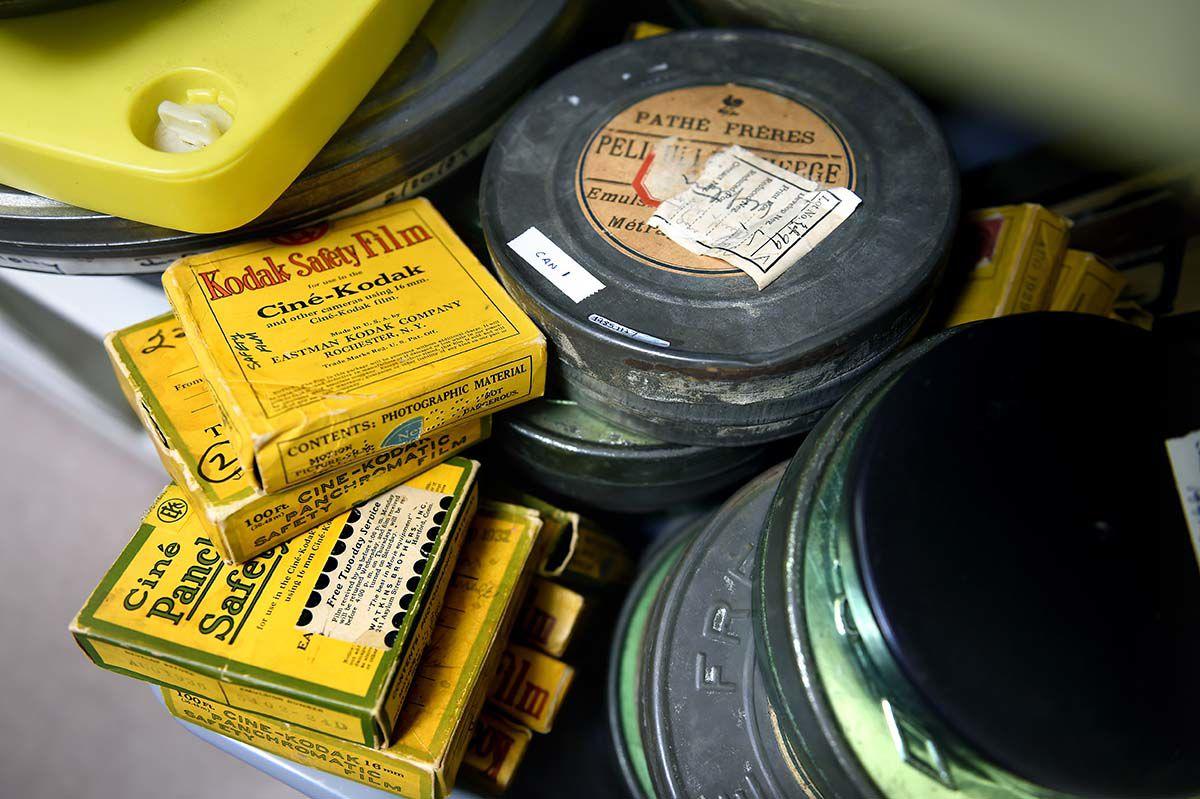
“Thanks to that grant for about $24,000 from the Institute of Museum and Library Services, the society was able to loan approximately 75 films to a company called George Blood LP, which specializes in digitizing audiovisual media.
CHS has about 50 more films in its collection but will have to apply for another grant to complete the digitizing project. The grant, received in September 2017, also allowed them to digitize thousands of photos and negatives as well as maps, architectural drawings, lithographs and posters.”
Click here to learn more about this project and how you can help. Tasha says, “I’m hoping people watch our films online, and if they have information about what’s depicted, they can contact us.”
Oral Histories
We recently stumbled upon two fascinating oral history resources now available online that we think you might enjoy.
First is the Voices of Liberation project, which has been set up to commemorate more than 100,000 service personnel who died in 1944.
The voices of Second World War veterans and their relatives are being recorded to mark the 75th anniversary of some of the conflict’s most momentous battles. It was started by the Commonwealth War Graves Commission, which hopes the archive will be a fitting tribute to the dead and highlight its cemeteries and memorials across the world. The public can contribute to this project at https://liberation.cwgc.org/.
If you have Irish ancestors, you might enjoy exploring Irish Life & Lore‘s oral history collections, totaling 3,000 hours. It was founded by Tralee-based oral historians Maurice and Jane O’Keeffe.
From their website: “Through our decades of work in the compilation of audio recordings and books for educational and commercial purposes, thousands of Irish voices from all regions of the country have been captured and archived for the future.” You can browse their collections and listen to samples, and individual recordings are available for purchase.
Tapping into Newspapers for Genealogy
If you’re interested in learning more about your family history, you’ve probably heard of several people say “be sure to check old newspapers!” Sounds great, right? But which newspapers were around back then? And where are they now?
Lisa Louise Cooke’s hit book provides you with a fool-proof research process including step-by-step instructions, worksheets and checklists, and a case study that puts it all together. Her methodology applies to newspaper research no matter where your ancestors came from and settled.
Click here to grab a copy of How to Find Your Family History in Newspapers, available in both print and digital download.

Lacey Cooke
Lacey has been working with Genealogy Gems since the company’s inception in 2007. Now, as the full-time manager of Genealogy Gems, she creates the free weekly newsletter, writes blogs, coordinates live events, and collaborates on new product development. No stranger to working with dead people, Lacey holds a degree in Forensic Anthropology, and is passionate about criminal justice and investigative techniques. She is the proud dog mom of Renly the corgi.
Disclosure: This article contains affiliate links and Genealogy Gems will be compensated if you make a purchase after clicking on these links (at no additional cost to you). Thank you for supporting Genealogy Gems!
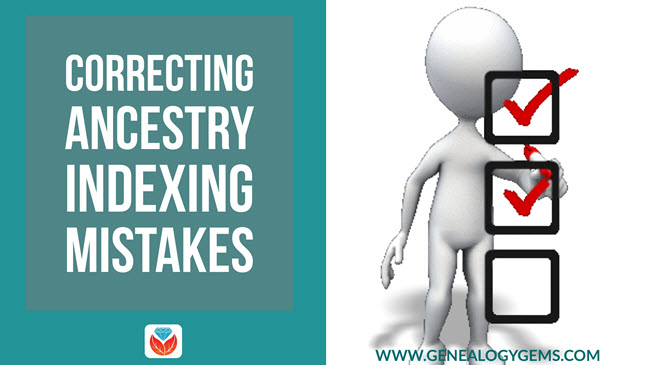
How to Correct Mistakes in Ancestry.com Indexes
Ancestry.com indexes aren’t always right, making it more difficult to search successfully for your ancestors in old records. In many cases, you can correct those errors and help others find it in the future. Here’s how to do it.
When the announcement was made that microfilm lending from the Family History Library was ending, we received many emails from disappointed fans. Vera, in Ontario, Canada, said she had appreciated the access to microfilmed records because, she says:

“I find the indexes and transcriptions for information digitized is often incorrect. This is especially true on Ancestry.com.”
Vera is right that you shouldn’t fully rely on indexes to tell you whether your ancestors appear in records! Indexers make mistakes when they transcribe names. Or, perhaps the indexer is transcribing it as it appears, but the spelling is different, or it’s just really tough to decipher. Sometimes it takes an informed descendant’s eye—like yours!—to read an entry correctly or to contribute a spelling that’s more common.
If you don’t find ancestors in indexed records where you think they should be, browse the digitized records page-by-page for that time period and locale. (Click here to read a post on how to browse records at FamilySearch.org: a similar technique applies at Ancestry.com and other sites.)
You can also use advanced search techniques, like searching without the first or last name (or both), searching instead with other known characteristics such as the gender, age, place, and another relative’s name.
User-submitted corrections in Ancestry.com Indexes
When you DO find your ancestor in an Ancestry.com record that was incorrectly indexed, you might be able to fix it! The site allows users to submit changes to any indexes they have created themselves. You may even have seen (and benefited from) user-submitted corrections in your search results already. They look like this: 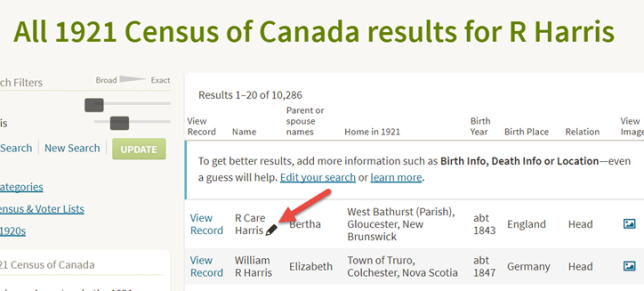
That listing you see means the record was originally indexed as R Care Harris, but someone has submitted a correction.
If you roll over the pencil icon, you’ll see a note that says, “Other possible names: Robert Carr Harris.” Click View Record to the left, and you’ll see the transcribed information: 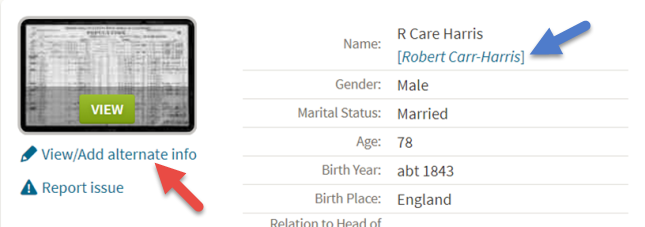
If you click where the blue arrow shows, on [Robert Carr-Harris], you’ll see that an Ancestry user submitted this name correction:
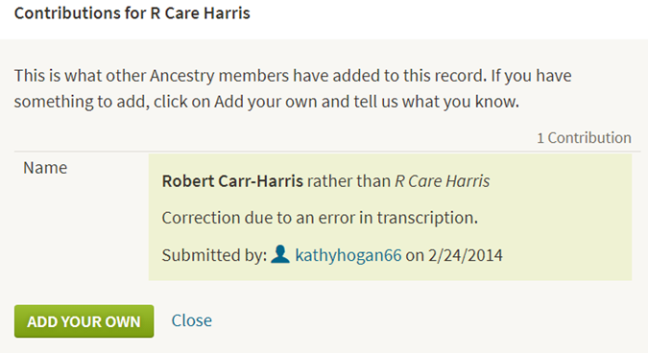
If you have a correction of your own to make to an Ancestry indexed entry, you may click where the red arrow is pointed above, to where it says View/Add alternate information. You’ll see this screen:
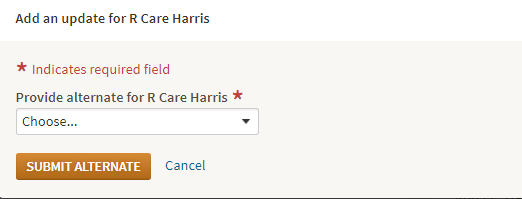
From the drop-down menu, you can choose which fields to correct. In the case of the 1921 Canadian census, you can choose from several different fields to correct, including the name, parents’ birthplaces, occupations, and more. You can even select a field that was left blank if you want to add information here.
As shown below, you must select a reason for making the change. Then you can enter what you think it should say and click Submit Alternate: 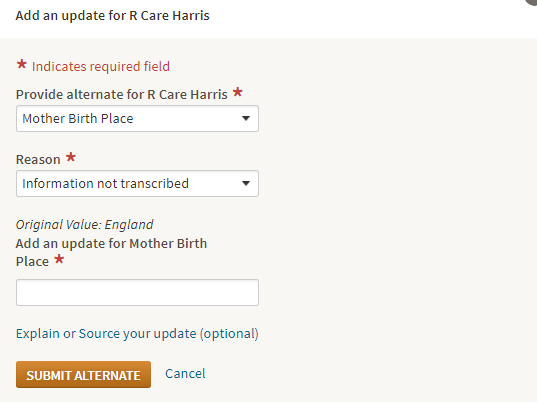
Your corrected version is then added to the searchable index to help others find the same record.
Remember, you can only do this in indexes that Ancestry.com has created itself (not indexes supplied by third parties). But that applies to a lot of major indexes, including several U.S. and Canadian censuses, draft registrations, passenger lists, and more.
Ancestry Pro Tip
An Ancestry user who has corrected an entry for one of your ancestors may be a good person for you to know about. If you’re a subscriber, you can click on the user name to see the user profile and send a message. The user profile may show an AncestryDNA test, recently-added content, any of that person’s public trees, and a personal description.
The user who corrected the entry above defines herself as an advanced genealogist who has been researching since 1985, does research almost every day, and is currently active on Ancestry.com. If Robert Care (or Carr) Harris were my ancestor, I would definitely want to meet her!
Learn How to Fix an Ancestry Online Family Tree:
(Click on player to unmute sound)
Pick the right records website for you!
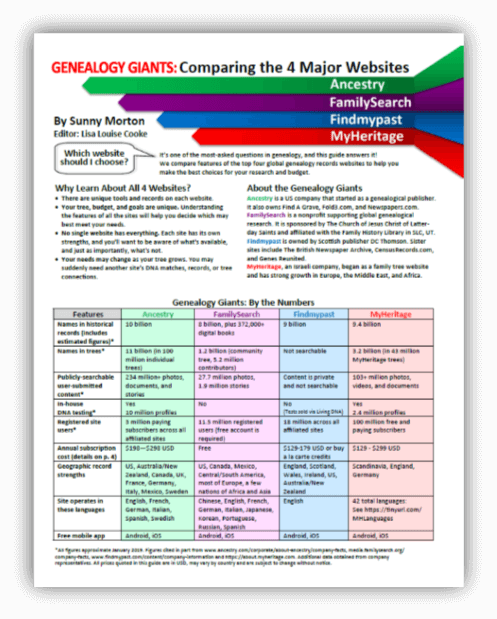
Disclosure: This article contains affiliate links and Genealogy Gems will be compensated if you make a purchase after clicking on these links (at no additional cost to you). Thank you for supporting Genealogy Gems!
This article was originally published on July 25, 2017 and updated on March 27, 2019.

